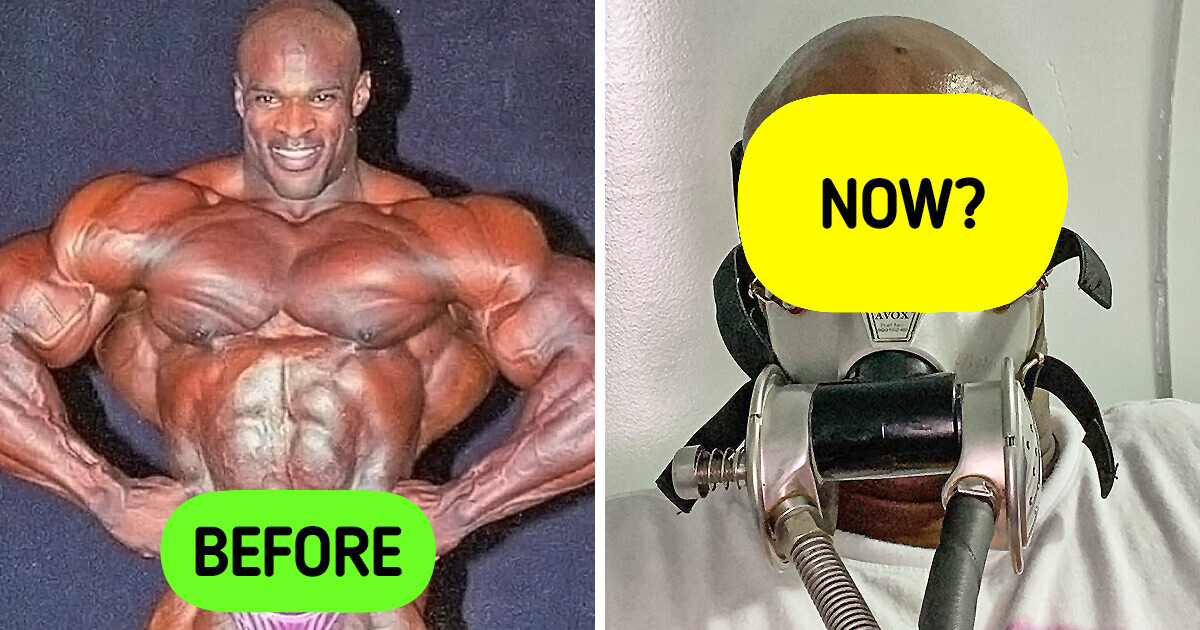“He Got Himself a Younger Lisa,” Jason Momoa’s New Girlfriend Bears a Striking Resemblance to His Ex-Wife


Coleman is the household name in the late ’90s and early 2000s bodybuilding scene! Thanks to his strength and excellent performance, he is recognized as one of the strongest bodybuilders ever. For example, he achieved records for performances like his iconic 800-pound squat, which got people around the world stunned. He beat records and secured the Mr. Olympia title eight times, and was called “The King”.
After many years of his successful career, we somehow lost the famous bodybuilder out of the public eye. That’s why we decided to find out the answer to the popular question: “What happened to Ronnie Coleman?”
Born on May 13, 1964, in Bastrop, Louisiana, Ronnie Coleman started as a college football player at Grambling State University, where he tackled opponents as a middle linebacker for coach Eddie Robinson.
After earning a degree in accounting, Coleman hoped to land a job dealing with numbers, but his plans hit a roadblock. Despite his efforts, he couldn’t secure work as an accountant after graduation. Feeling the pinch of financial strain, he took a different route and found employment at Domino’s Pizza. The struggle was real, and he survived on the free pizza he got from work, given his tight budget.
In a surprising turn of events, Coleman shifted gears and became a police officer in Arlington, Texas, serving in this role from 1989 to 2000. Even after his official term, he continued as a reserve officer until 2003. This unexpected journey from aspiring accountant to a pizza employee and then a police officer laid the groundwork for what would eventually become Coleman’s iconic career in bodybuilding, showcasing his resilience in the face of challenges and the twists life can take.
During his time as a police officer, Coleman continued to pursue his passion for bodybuilding, balancing the demands of law enforcement with his dedication to the sport. The contrast between his roles in the police force and his rising prominence in bodybuilding paints a vivid picture of Coleman’s multifaceted journey. His unwavering commitment to both his civic duty and athletic pursuits highlights the extraordinary nature of his accomplishments, showcasing a unique and inspiring blend of roles in his life.
In his journey, Ronnie Coleman embarked on a pivotal chapter by training at the renowned Metroflex Gym in Arlington. This transformative step was suggested by his fellow officer, Gustavo Arlotta, who pointed him to the gym owned by amateur bodybuilder Brian Dobson. Dobson, seeing potential in Coleman, offered him a remarkable deal: a free lifetime membership at Metroflex if he allowed Dobson to train him for the upcoming 1990 Mr. Texas bodybuilding competition.
Taking on this opportunity, Coleman delved into the world of bodybuilding, participating in local competitions. In 1990, he clinched the title of Mr. Texas, marking the commencement of his journey in the professional circuit. The following year, he turned pro by triumphing at the International Federation of Bodybuilding & Fitness (IFBB) World Amateur Championships. His pro debut at the 1992 Mr. Olympia saw him finish outside the top 15, but this setback didn’t deter him.
Coleman persisted, returning to the Olympia stage in 1994, securing 15th place. However, his breakthrough came in 1995 with his first pro win at the Canada Pro Cup, propelling him to the 11th spot at the Olympia that year. The subsequent years witnessed his ascent, as he clinched the Canada Pro Cup again in 1996, reaching the impressive sixth position at the Olympia.
Despite these triumphs, a setback at the 1997 Ironman contest briefly led Coleman to contemplate retirement. Placing third behind Lee Priest, he deemed it the most “painful” loss of his career. Nevertheless, Coleman persisted, finishing ninth at the 1997 Mr. Olympia.
A turning point came after the Olympia, as Coleman emerged victorious on an international tour with the IFBB, defeating Kevin Levrone at the Grand Prix. This triumph marked the beginning of his unparalleled rise to the pinnacle of the bodybuilding world.
Ronnie Coleman’s remarkable success in professional bodybuilding opened doors to numerous product endorsements and diverse opportunities in his expansive career. Embracing these prospects, he embarked on a globetrotting journey, promoting products and making guest appearances at gym openings across the United States. His influence extended far beyond the competitive stage, as he became a sought-after figure in the fitness industry.
Notably, Coleman’s training philosophy distinguished him. Preferring free weights over machines, he aimed to enhance his flexibility and maximize his range of motion. This preference reflected in the three training videos he created: “The Unbelievable,” “The Cost of Redemption,” and “On the Road.” In these videos, he shared valuable tips for seasoned weightlifters, emphasizing the importance of avoiding overexertion and maintaining proper form.
One distinctive aspect of Coleman’s approach to training was his preference for free weights over machines. This choice aimed to enhance flexibility and maximize the range of motion in his exercises. It was a philosophy he actively shared in his training programs. In these videos, he imparted valuable tips for seasoned weightlifters, emphasizing the crucial aspects of avoiding overexertion and maintaining proper form.
Coleman’s journey to greatness reached a significant milestone in 1998 when he secured the first of an unprecedented eight consecutive Mr. Olympia titles. Despite the demands of defending this ultimate bodybuilding championship and his global ambassadorial role for muscledom, Coleman never relented. Instead, he continued to grow both in size and strength.
In 2000, as part of his preparation for the third Mr. Olympia win, Coleman displayed incredible feats, deadlifting 755 lbs (342 kg) for four repetitions and an astonishing 800 lbs (362 kg) for two repetitions. Similarly, in 2003, gearing up for his sixth Mr. Olympia win, he squatted an awe-inspiring 800 lbs (362 kg) for two repetitions. Remarkably, these astounding lifts weren’t part of his routine training but were done for workout videos, later sold on DVDs. Despite this, Coleman maintained a commitment to heavy training, exemplified by a 495-pound bench press for five repetitions in 2003.
Amid his extensive training regimen, one exercise remained central— the barbell squat. Despite attributing his initial injury as a teenager and his first herniated disc in 1997 to this exercise, Coleman persisted in squatting heavily throughout his competitive years. In 2005, before securing his eighth and final Mr. Olympia win, he squatted an impressive 585 pounds for 10 deep repetitions, pushing himself to the limit until his nose bled. At the age of 41, he continued to defy expectations, front squatting 495 for 10 repetitions at 42. His dedication was evident in his consistent leg training routine, incorporating back squats in one workout and front squats in another, demonstrating an unparalleled commitment to his craft.
Ronnie Coleman’s dietary regimen was meticulously crafted to fuel his extraordinary physique. A substantial portion of his diet comprised 20-25% carbohydrates, 5-10% fats, and a whopping 65% protein. Notably, Coleman prioritized protein intake, often relying on several scoops of protein powder shakes to meet his nutritional needs. His approach echoed his belief that protein played a pivotal role in muscle-building, as he emphasized, “The most important thing about nutrition is protein, as it is the main ingredient that builds muscle”.
In addition to his strict dietary principles, Coleman supplemented his nutrition to ensure his body received the necessary nutrients. These supplements played a crucial role in supporting his intensive training and maintaining his colossal physique during the peak of his career. He primarily took:
During a candid interview on comedian and UFC commentator Joe Rogan’s podcast, Coleman shed light on various aspects of his bodybuilding journey, training methods, and dietary practices. This conversation offered a unique insight into the life of the former bodybuilding icon. Coleman’s revelations about his body fat ratio and dietary habits surprised both Rogan and the audience, underscoring the intensity and dedication required to sustain such a colossal physique.
Coleman disclosed that his regimen included heavy lifting and a substantial daily intake of calories. He aimed to gain 5–10 pounds of muscle annually through this rigorous routine. His daily meals were a testament to his commitment, consisting of approximately 450 grams of chicken, grilled chicken breast, and a half cup of rice. Consuming about six meals a day, Coleman’s disciplined approach to nutrition played a pivotal role in sculpting his legendary physique, earning him the moniker “The Big Hulk.”
Ronnie Coleman’s journey after his last competition at the 2007 Mr. Olympia has been marked by an enduring battle against severe back pain. Remarkably, it wasn’t until this final competition that he chose to address the persistent pain that had plagued him for a decade. A doctor had recommended spinal surgery a decade earlier, but Coleman delayed it, winning eight Mr. Olympia titles and enduring countless sets of squats before finally seeking medical intervention.
The aftermath of his first surgery set a challenging precedent, marking the beginning of a series of surgeries, none of which brought lasting relief. In 2014, he underwent a double hip replacement, a significant step to alleviate the toll his body had taken. However, unforeseen challenges awaited him in 2015. After a long flight abroad, Coleman experienced heightened back pain, escalating rapidly to the point where he found himself reliant on crutches just two days later. Upon his return to Texas, a marathon 13-hour back surgery took place in December 2015, initiating a downward trajectory in his health.
The year 2018 unfolded as a series of daunting medical challenges for Coleman, with three spinal surgeries within that period. The procedures included vertebrae fusion, repairing broken screws from a previous surgery, and replacing all the screws with larger ones. In the aftermath of his third surgery in 2018, Coleman candidly shared his struggle, shedding light on the physical toll these surgeries were taking on his body.
In an interview afterward, he shared: “I don’t know if [walking without crutches] will ever happen because I’ve had too much damage done to my body from all these surgeries. A lot of it has to do with the way the surgeon performed the surgery; and the surgeon that I’ve had the last three surgeries has been really bad and caused a lot of damage to my body. So I don’t know if I’ll be able to walk, but I’m gonna give it my best shot. But I think if that surgeon had to perform these surgeries right, then I would have been walking a long, long time ago... Just the way [the surgeon] did everything and performed everything it was like he was kind of doing these surgeries to make money, ’cause every surgery I’ve had done was like $300,000 to $500,000. The last three surgeries I had, I spent almost $2 million dollars.”
The trials did not end there for Coleman. In 2020, facing a broken socket, he underwent his second double hip replacement. Astonishingly, Coleman’s surgical count reached a staggering 13, spanning his hips (twice), neck (twice), and back (nine times). All 25 spinal discs underwent surgical intervention, resulting in a fully fused spinal column, with the exception of one herniated disc.
In a revealing interview with Joe Rogan in 2020, Coleman painted a vivid picture of his reconstructed spine, describing it as comprising 14 screws, two cages to hold discs together, and two rods measuring 18 inches in length. Despite the physical toll and the extensive surgical history, Coleman faced his challenges with resilience, sharing his journey to inspire others and emphasize the sacrifices he made in pursuit of bodybuilding greatness.
He felt his first back injury when attempting to squat 500 in a powerlifting meet at 17. In his words: “Suddenly, something happened. CRACK. I instantly felt like a giant flash of lightening penetrated my lower back, burning my entire backside.”
When squatting 600 for repetitions in 1997 he severely herniated a disc. “Eventually, despite my utmost caution and being at the chiropractor at least once a week, it was only going to be a matter of time before the injuries I had suffered in the football field and in the powerlifting team were going to be exacerbated and come back to bite me,” Ronnie writes.
At present, Ronnie Coleman relies on crutches to walk short distances due to weakness in his legs caused by nerve damage in his back. Despite these challenges, he maintains a regular workout routine with lighter weights and adheres to a bodybuilder’s diet, albeit with three meals a day instead of six or more during his competitive years. Celebrating his 59th birthday on May 13, he juggles family life with owning a successful nutritional supplement line.
In response to Joe Rogan’s inquiry about continuing to lift weights despite multiple surgeries, Coleman expressed unwavering dedication. He emphasized that doing what he truly loves brings him joy, even amidst persistent pain. Despite being in constant discomfort, Coleman remains resolute, asserting that as long as he can engage in his passion, he is content.
Ronnie Coleman acknowledges the persistent pain he endures, but believes that pursuing his passion is what keeps him okay. His commitment to weightlifting remains unwavering, providing him solace and purpose. Seeking avenues to alleviate pain and regain mobility, Coleman has undergone stem cell treatments and hyperbaric therapy in Puerto Vallarta, Mexico, since October 2020. Expressing hope on Instagram, he stated, “As long as I have a plan, I have a chance. As long as I’m alive, I have a chance to survive and overcome this obstacle.” Despite the ongoing challenges, Coleman remains resilient and optimistic, focusing on the possibilities ahead.
What happened to Ronnie Coleman? Now you know! The story is full of hard work and dedication, inspiring and hurtful at the same time, truly. Do you want to read more stories, that will touch your heart? Then make sure to read our next article!











